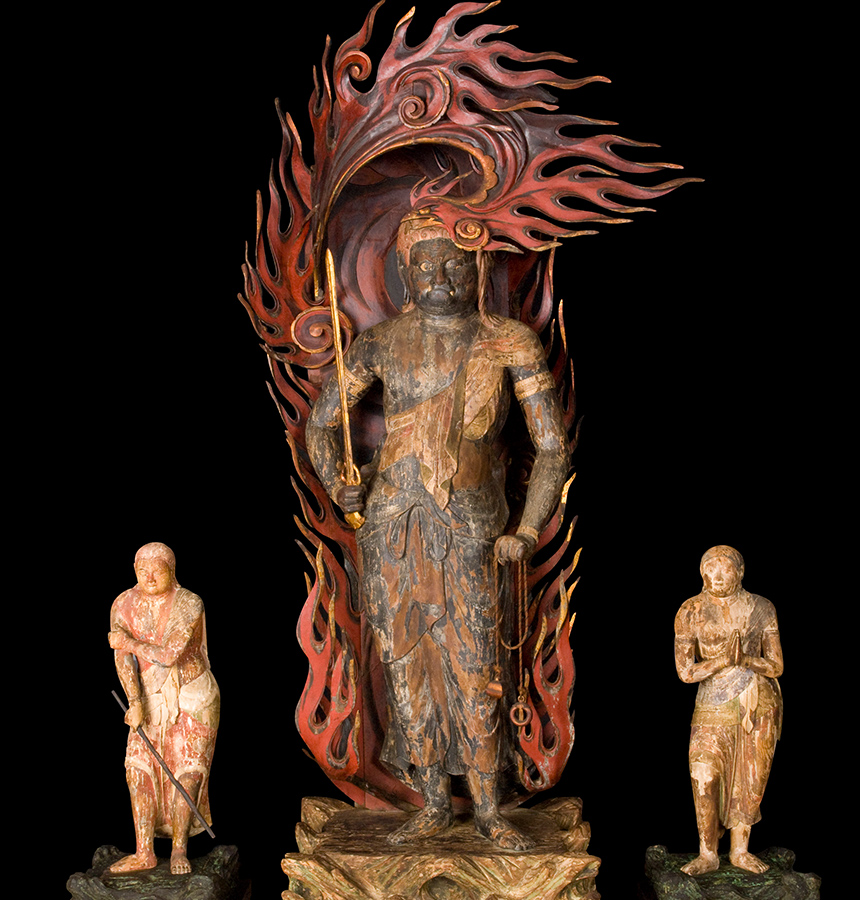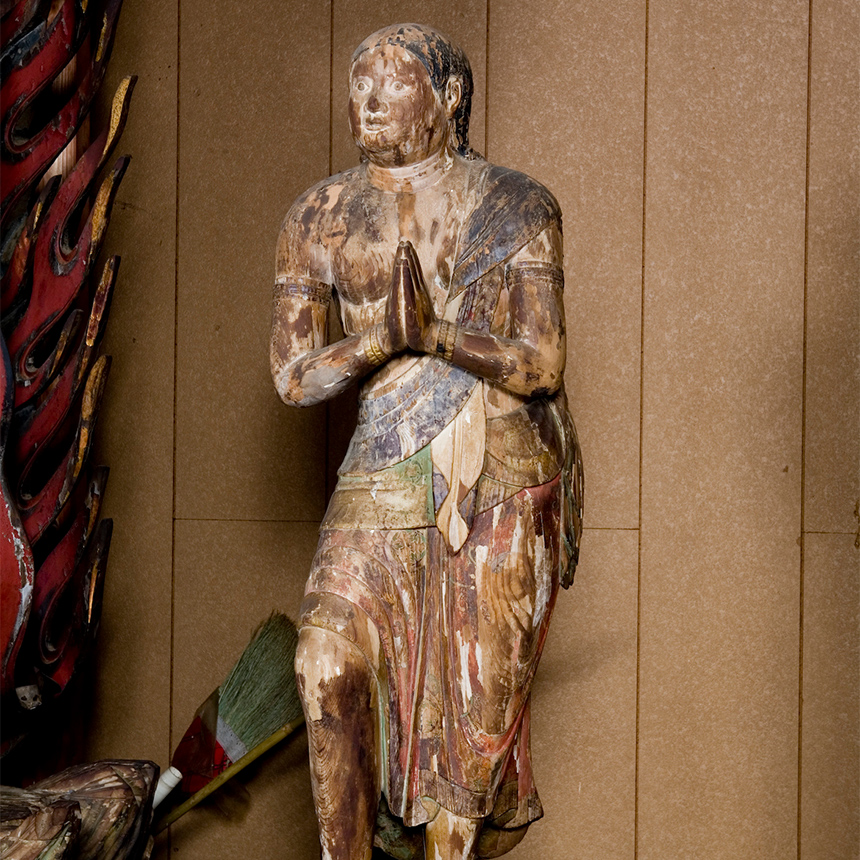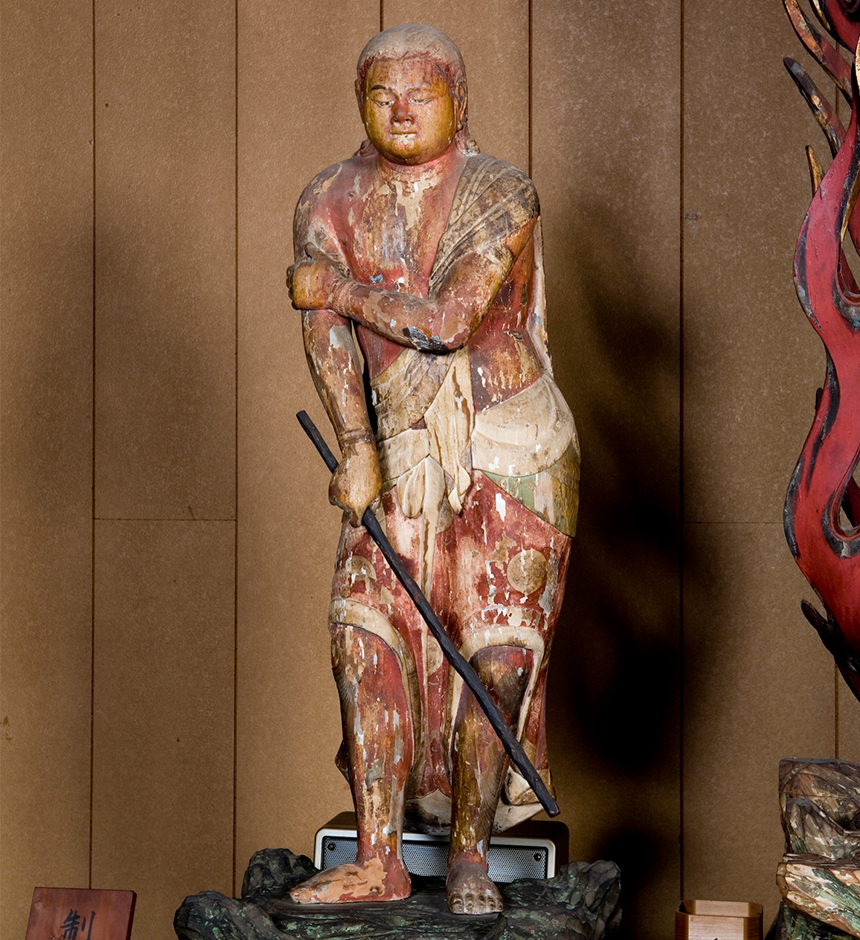Deities of Kunisaki and Beyond

Myo-o
Vidyarajas
The Vidyarajas, or Mantra Kings, are five fierce looking guardians that remove all obstacles to enlightenment. They startle and threaten the recalcitrant and stubborn. They possess the knowledge and spiritual force contained in mantras. According to esoteric teachings, since they eliminate all the obstructions within and around us, the Mantra Kings and the mantras associated with them are effective in accomplishing the attainment of Buddhahood in the present lifetime.
In appearance the Mantra Kings are nearly always ferocious. Their flamelike hair, glaring eyes, bared fangs and the weapons they carry inspire dread. Through these attributes they are able to defeat selfishness and weakness. Initially considered as esoteric deities, they were popularised from the 13th Century. Fudo Myo-o is the central figure of the Mantra Kings.
Fudo Myo-o
Achalanatha

Mainly represented in Japan, Fudo is the chief of the five Vidyarajas (Japanaese Myo-o), the Kings of mystic or magical knowledge symbolising the power and victory of the five Jinas over the passions and desires. Fudo’s wrathful, irritated expression ‘demonstrates the wrath of the great compassion which brings to beings the succour of the Good Law’. He has the power to crush all obstacles and all troubles. He is shown either seated or standing. Generally, he holds a sword to combat the ‘three poisons’ of greed, anger and ignorance. He also holds a lasso to catch and bind the evil forces and prevent them from doing harm. His hair hangs down in a plait on his left shoulder. His brow is furrowed, his left eye is half open, and his right eye stares. Two fangs protrude, one up and one down, from his mouth. A portly figure he appears in front of an aureole of flames.
From the late 8th Century Fudo Myo-o became much more popular in Japan than he had ever been in either India or China. His cult was introduced from China into Japan by Kukai (Kobo-Daishi), the founder of the Shingon Sect. His image is sometimes seen on ema, votive tablets, in Shinto shrines for protection against calamities. In Japan, he belongs equally to Buddhism and to the syncretism underlying many aspects of Shinto and Buddhism, the distinction is often blurred in the eyes of followers.
Doji
Acolytes of Fudo Myo-o
Myo-o is sometimes accompanied by eight child acolytes of which 2, Seitaka and Kongara are usually close to him. Although Fudo can be represented with two, eight, 36 or 48 acolytes, he is usually represented with two, Seitaka and Kongara.
Kongara Doji

Always placed on the left of Fudo, he holds a sword and a rope.
Seitaka Doji

Seitaka Doji is usually placed on the right of Fudo. His arms are crossed over his breast, or he holds a staff in the right hand and a triple vajra in the left.
Shomen Kongo
Shomen Kongo is represented standing with serpents writhing around his body and lying coiled on his head. His hair is bristling, fangs protrude from his mouth, he has a third eye and wears a furious expression. The deity has six arms. He is thought to punish malice and wage war on the demons of sickness.
Shomen Kongo is the principal deity of the Koshin cult, created in Japan at the end of the middle ages on the basis of Taoist concepts. He is often represented with the Sanen, three monkeys that ‘see no evil, hear no evil, speak no evil’. Sanen became popular in the Edo Period. Sanen is a famous motif of the Toshogu Shrine at Nikko. This shrine is the mausoleum of the great shogun Tokugawa Ieyasu and it is also dedicated to Tokugawa’s Shinto deity incarnation, Toshogu Gongen.
Taoist superstition held that if a person slept on the night before a Koshin day, the three worms which dwell in everyone would crawl out and fly upwards to report that person’s misdeeds to the Emperor of Heaven. To prevent this, believers drank and caroused throughout the Koshin night, without sleeping. Koshin days occur six times yearly and Koshin years occur in the 57th year of the sixty year cycle, a Chinese Zodiac system. Koshin-to, usually round stones, are placed at passes, crossroads and entrances to villages and towns to ward off plague and attack.




